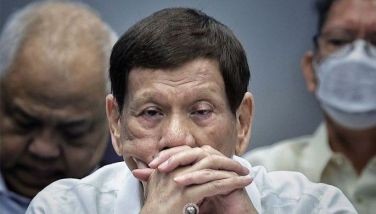Mahihirap 'di kumonti kahit bumaba ang poverty estimates — IBON

MANILA, Philippines — Kwestyonable raw ang mga datos na inilabas ng Philippine Statistics Authority nitong Miyerkules tungkol sa kahirapan nitong 2018, sabi ng isang economic think tank.
Ayon sa IBON Foundation, napakababa raw kasi ang itinakdang standard of living na katanggap tanggap sa gobyerno para 'di matawag na mahirap.
Sa datos na ginamit ng gobyerno, lumalabas daw kasi na mahigit-kumulang P69.50 lang ang kitang kailangan ng tao araw-araw para matugunan ang "basic food and non-food needs."
"The standard of living allowed by the official poverty line is very low and grossly underestimates the real number of poor Filipinos," sabi ni Sonny Africa, executive director ng IBON, kahapon.
Nanggaling 'yan sa P10,481 na poverty threshold na itinakdang sukatan para sa pamilyang lima ang miyembro kada buwan sa unang semestre ng 2018.
Ayon sa PSA, isinasalarawan ng poverty theshold ang:
"...minimum income required to meet the basic food and non-food needs such as clothing, fuel, light and water, housing, rental of occupied dwelling units, transportation and communication, health and education expenses, non-durable furnishing, household operations and personal care and effects."
"These are grossly underestimated thresholds that do not meet decent minimum standards for food, shelter, transportation, utilities, health care and education," dagdag ni Africa.
Itinakda naman ang mahigit-kumulang P48.60 bilang food threshold kada tao araw-araw sa unang semestre ng 2018.
Nanggaling 'yan mula sa 'di bababa sa P7,337 para matugunan ang pagkain ng pamilyang may limang miyembro kada buwan.
Isinalarawan ng PSA ang food threshold bilang:
"...minimum income required to meet the basic food needs, satisfying the nutritional requirements set by the Food and Nutrition Research Institute (FNRI) to ensure that one remains economically and socially productive."
Pagbaba ayon sa statistics authority
Sabi ng PSA, 21% ng Pilipino (o 23.1 milyon) ang masasabing mahirap sa unang semestre ng 2018, mas mababa sa 27.6% (28.8 milyon) na naitala sa parehong panahon noong 2015.
"21% of Filipinos did not have the income needed to meet their minimum basic food needs and non-food needs in the first semester of 2018," sabi ng ahensya.
Sa lebel ng pamilya, naitala ang 16.1% poverty incidence sa unang kalahati ng 2018, mas mababa sa 22.2% na nai-record sa parehong panahon noong 2015.
Gumamit ng sample size na 180,000 households para makapagbigay ng sapat na estimates mula sa provincial level at highly urbanized cities.
"Over the course of three years, we can see that poverty [among population] decreased substantially — down by 6.6 percentage points — thanks to sustained economic growth and critical and broad-based reforms and investments that have translated to employment generation and social protection," sabi sa statement ng National Economic and Development Authority na binasa ni officer-in-charge Adoracion M. Navarro.
'I-review ang methodology'
Ayon sa IBON, kailangan nang baguhin ng PSA ang mga ginagamit na pamantayan para ipinta ang tunay na mukha ng kahirapan.
"The subsistence and poverty thresholds are in dire need of updating and upgrading according to more decent standards," ayon kay Africa.
Pero paano nga ba kwinekwenta ng PSA ang kanilang datos?
"The PSA estimates the poverty threshold by first computing a subsistence or food threshold and then mechanically multiplying this by a factor of around 1.43 to get the poverty threshold. These are both problematic," dagdag ng ekonomista na dating staff ng NEDA.
Ine-estimate daw ang subsistence food basket gamit ang "least cost" at "revealed preference" approach.
"These result in an extremely cheap food menu, which, while technically meeting bare nutritional requirements, is not just sorely lacking in variety but also only hypothetically available for families," paliwanag niya.
Hindi rin daw katanggap-tanggap ang paggamit ng pamahalaan ng "crude multiplier" para kwentahin ang non-food items.
Hindi raw kasi nito naco-compute ang budget na kailangan ng pamilya tulad ng tirahan, transportasyon, utilities, healthcare at edukasyon na maya't maya raw tumataas.
Taong 2015, na-estima ng IBON sa Family Income and Expenditure na ang 50% ng pinakamahihirap (11.4 milyon) pamilya ang may monthly income na P15,000 pababa, habang ang 60% ng pinakamahirap (13.6 milyon) pamilya ang kumikita ng P18,000 pababa.
Para sa kanila, political choice maituturing ang pagpili ng poverty line.
"Setting a high standard indicates the government having a high level of ambition for poverty eradication... setting a low standard indicates low targets and results in tens of millions of Filipinos... hidden behind unrealistic official poverty statistics," panapos ni Africa.
- Latest
























